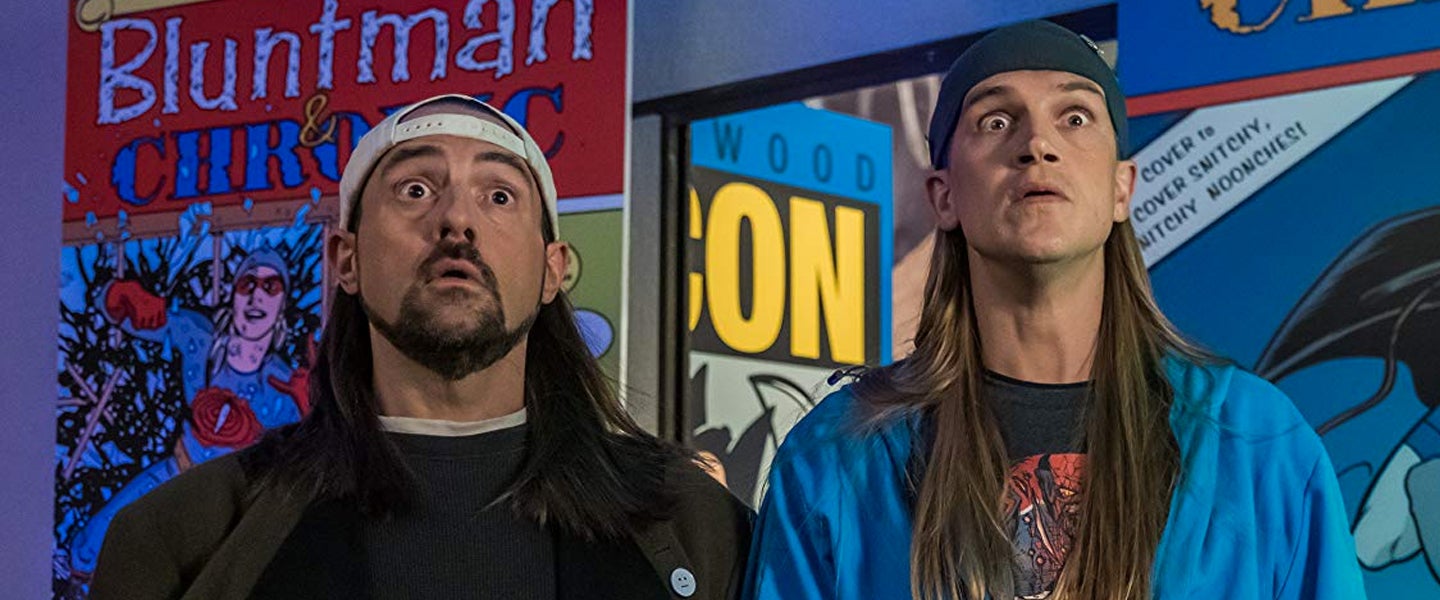In October of 1994 — 25 years ago — cinephiles across the U.S. were excited about the release of two movies they’d been reading about for months. At the Sundance Film Festival back in January of that year, writer-director Kevin Smith had the year’s first big buzz hit with Clerks, a micro-budget comedy about one wacky day in the lives of foul-mouthed New Jersey counter-jockeys. Then in May, Quentin Tarantino won the Palme d’Or at Cannes with his twisty post-modern neo-noir Pulp Fiction. Both pictures became money-makers for their shared distributor, Miramax; Smith and Tarantino were lumped together as leaders of an emerging generation of fannish filmmakers, many of whom learned their craft in video stores.
This summer, Tarantino was back at Cannes with his ninth feature film, Once Upon a Time in Hollywood. An ambitious and deeply personal reimagining of Charles Manson-era L.A., the movie is in some ways a culmination of a career that’s seen Tarantino reshape tawdry action thrillers, two-fisted war stories, Westerns and heist pictures in his own image. Hollywood has been a huge international hit, too — it cost nearly $100 million to produce, but it’s made over $350 million worldwide.
Smith, meanwhile, just made Jay and Silent Bob Reboot, a movie that revisits most of the characters the director has introduced in his various “View Askewniverse” films: Clerks, Clerks II, Mallrats, Chasing Amy, Dogma and Jay and Silent Bob Strike Back. The project reportedly cost $10 million, which theatrical distributors Saban Films, Universal Pictures and Fathom Events, plan to recoup through special screenings and a roadshow tour, aimed directly at Smith’s longtime fans, rather than at a wide general audience.
There are a few ways to look at the arc of Smith’s career, in comparison to his contemporaries. The generous reading — and probably the right one — is that he’s doing just fine. There’s no indication that he’s hurting for money. The people who love his work really love it. He’s always seemed like a good person: compassionate, enthusiastic, generous and grateful. At the first of Fathom’s special presentations earlier this week, Smith talked in his intro about the heart attack he suffered last year, and how as he was hovering near death in the hospital, all he could think about was what a bummer it’d be if he never got to make another Jay and Silent Bob movie. That’s genuinely sweet.
On the other hand, Jay and Silent Bob Reboot is, well, not great. Aside from the characters being 18 years older, the new movie is essentially a self-conscious retread of 2001’s Jay and Silent Bob Strike Back, with Smith and his longtime screen partner Jason Mewes reprising their roles as two affable Jersey pot-dealers who keep stumbling into strange adventures as they hit the road on a mission to keep Hollywood from profiting off their ideas.
The film is loaded with fans-only in-jokes: from Smith’s past struggles with his weight (and his subsequent conversion to a vegan diet) to cameo appearances from nearly every name actor who’s ever been in one of his movies. It’s all very congenial, true — a running subplot about a next-generation ne’er-do-well (played by Smith’s own daughter, Harley Quinn Smith) has real heart. But there’s not a lot new or inspired here. Jay and Silent Bob Reboot is mostly just a low-dose nostalgia-drip, for 105 minutes.
Again: There’s nothing wrong with this, per se. If making this kind of picture over and over keeps Smith happy and his fans happy, so be it. After all, it’s not like the movies Smith has made outside of his View Askewniverse have been masterpieces. Zack and Miri Make a Porno and Red State were interesting departures, and he’s done some good work as a guest director on geek-friendly TV shows like The Flash and Supergirl. But even Smith would probably admit he doesn’t have a Once Upon a Time in Hollywood in him.
Still, it does raise the question of what keeps certain filmmakers locked into making the same movies. Is it just a case of giving the people what they want? Or are they following their own muse?
Just last month, Fathom Events did fairly well with a special three-night run of 3 from Hell, the latest installment in Rob Zombie’s “Firefly” series, following 2003’s House of 1000 Corpses and 2005’s The Devil’s Rejects. Zombie has made daring films in the 14 years since The Devil’s Rejects, such as 2012’s The Lords of Salem, a deeply felt tale of sorcery and addiction. In 2016, though, he partnered with Fathom Events for another limited run for 31, a movie disappointingly derivative of his earlier work; and now comes 3 from Hell, which repeats a lot of the thematic concerns and 1970s drive-in schtick of the earlier Firefly films. That’s two consecutive projects offering more or less what Zombie’s fans have bought from him before.
This isn’t uncommon with filmmakers known for horror. John Carpenter and Joe Dante excelled at multiple genres in the 1970s, 1980s and 1990s, but in the 21st century, the few movies they’ve gotten to make have nearly all been shockers, and nearly all of them pale next to the likes of Halloween, The Thing, Piranha and The Howling. Before George Romero died, the last three films he made were all hit-and-miss continuations and/or reinventions of the zombie saga he began in 1968 with Night of the Living Dead. Romero made more than one non-zombie classic in his lifetime (Martin and Knightriders are both knockouts.) But toward the end, he’d become like a once-popular band on a reunion tour, paid to play the hits.
It needn’t be this way. Martin Scorsese recently got under the skin of Marvel Cinematic Universe fans by saying he’s not really interested in watching those movies, because the ones he’s seen don’t seem like cinema to him. Some devoted MCU-heads fired back, saying Scorsese’s a one-note director who only makes films about gangsters, which is, of course, ridiculous. Scorsese’s filmography is vast and varied, including documentaries, musicals, romances, period dramas and earnest inquiries into spirituality and religion.
To be fair, every so often Scorsese does revisit gangland, looking at crime and criminals with fresh eyes in pictures like Mean Streets, Goodfellas, Casino, The Departed and the upcoming The Irishman. The key words there, though, are “fresh eyes.” Some of the stylistic tics carry over from film to film: the exhilaratingly frenetic montages, the classic rock soundtracks, et cetera. But the movies themselves explore these characters and their violent, self-indulgent lives from different perspectives. The restless, soul-sick young man who made Mean Streets wouldn’t have had the perspective and patience to make The Departed.
The guy who made Clerks and Mallrats, however? He totally could’ve made pretty much all of Jay and Silent Bob Reboot… like, basically everything but the sentimental scenes about parenting. And perhaps that’s why Smith’s remaining audience is so devoted: Because he can still tap into that thing they loved about him in 1994. But at a certain point, perhaps sooner rather than later, it may start seeming like a waste of everyone’s time to return every few years to slap a new cover on the same book.

